Si-Based Polarizer and 1-Bit Phase-Controlled Non-Polarizing Beam Splitter-Based Integrated Metasurface for Extended Shortwave Infrared
Abstract
:1. Introduction
2. Structure Design and Theoretical Analysis
2.1. Analysis of the Design Principle of the Polarizer with Arbitrary Polarization Control Angle
2.2. Analysis of the Design Principle of the NPBS with a Phase Difference of π
3. Numerical Simulation and Optimization
3.1. The Metasurface Polarizer
3.2. The Metasurface NPBS
4. Conclusions
Author Contributions
Funding
Data Availability Statement
Conflicts of Interest
References
- Zheludev, N.I.; Kivshar, Y.S. From metamaterials to metadevices. Nat. Mater. 2012, 11, 917–924. [Google Scholar] [CrossRef] [PubMed]
- Liu, Y.; Zhang, X. Metamaterials: A new frontier of science and technology. Chem. Soc. Rev. 2011, 40, 2494–2507. [Google Scholar] [CrossRef] [PubMed]
- Su, V.C.; Chu, C.H.; Sun, G.; Tsai, D.P. Advances in optical metasurfaces: Fabrication and applications. Opt. Express 2018, 26, 13148–13182. [Google Scholar] [CrossRef]
- Zhao, Y.; Liu, X.X.; Alù, A. Recent advances on optical metasurfaces. J. Opt. 2014, 16, 123001. [Google Scholar] [CrossRef]
- Kamali, S.M.; Arbabi, E.; Arbabi, A.; Faraon, A. A review of dielectric optical metasurfaces for wavefront control. Nanophotonics 2018, 7, 1041–1068. [Google Scholar] [CrossRef]
- Hoang, A.M.; Chen, G.; Haddadi, A.; Abdollahi Pour, S.; Razeghi, M. Demonstration of shortwavelength infrared photodiodes based on type-II InAs/GaSb/AlSb superlattices. Appl. Phys. Lett. 2012, 100, 211101. [Google Scholar] [CrossRef]
- Dehzangi, A.; Haddadi, A.; Chevallier, R.; Zhang, Y.; Razeghi, M. Fabrication of 12 µm pixel-pitch 1280 × 1024 extended short wavelength infrared focal plane array using heterojunction type-II superlattice-based photodetectors. Semicond. Sci. Technol. 2019, 34, 03LT01. [Google Scholar] [CrossRef]
- Nordin, G.P.; Meier, J.T.; Deguzman, P.C.; Jones, M.W. Micropolarizer array for infrared imaging polarimetry. J. Opt. Soc. Am. A 1999, 16, 1168–1174. [Google Scholar] [CrossRef]
- Chu, J.; Wang, Z.; Guan, L.; Liu, Z.; Wang, Y.; Zhang, R. Integrated polarization dependent photodetector and its application for polarization navigation. IEEE Photon. Technol. Lett. 2014, 26, 469–472. [Google Scholar]
- Intaravanne, Y.; Chen, X. Recent advances in optical metasurfaces for polarization detection and engineered polarization profiles. Nanophotonics 2020, 9, 1003–1014. [Google Scholar] [CrossRef]
- Feng, B.; Chen, Y.; Sun, D.; Yang, Z.; Yang, B.; Li, X.; Li, T. Precision integration of grating-based polarizers onto focal plane arrays of near-infrared photovoltaic detectors for enhanced contrast polarimetric imaging. Int. J. Extrem. Manuf. 2021, 3, 035201. [Google Scholar] [CrossRef]
- Lin, D.; Melli, M.; Poliakov, E.; Hilaire, P.S.; Dhuey, S.; Peroz, C.; Klug, M. Optical metasurfaces for high angle steering at visible wavelengths. Sci. Rep. 2017, 7, 2286. [Google Scholar] [CrossRef]
- Yang, W.; Xiao, S.; Song, Q.; Liu, Y.; Wu, Y.; Wang, S.; Tsai, D.P. All-dielectric metasurface for high-performance structural color. Nat. Commun. 2020, 11, 1864. [Google Scholar] [CrossRef]
- Mueller, J.B.; Rubin, N.A.; Devlin, R.C.; Groever, B.; Capasso, F. Metasurface polarization optics: Independent phase control of arbitrary orthogonal states of polarization. Phys. Rev. Lett. 2017, 118, 113901. [Google Scholar] [CrossRef] [PubMed]
- Shi, L.; Lu, L.; Chen, G.; Feng, Y.; He, Y.; Ren, G.; Zhu, L. GaAs Linear Polarizer with a High Extinction Ratio for Extended Short-Wave Infrared Detection. Photonics 2023, 10, 489. [Google Scholar] [CrossRef]
- Attiaoui, A.; Bouthillier, É.; Daligou, G.; Kumar, A.; Assali, S.; Moutanabbir, O. Extended Short-Wave Infrared Absorption in Group-IV Nanowire Arrays. Phy. Rev. Appl. 2021, 15, 014034. [Google Scholar] [CrossRef]
- Chevallier, R.; Haddadi, A.; McClintock, R.; Dehzangi, A.; Lopez-Dominguez, V.; Amiri, P.K.; Razeghi, M. High Frequency Extended Short-Wavelength Infrared Heterojunction Photodetectors Based on InAs/GaSb/AlSb Type-II Superlattices. IEEE J. Quantum Electron. 2018, 54, 1–5. [Google Scholar] [CrossRef]
- Rizea, A. Design technique for all-dielectric non-polarizing beam splitter plate. Opto-Electron. Rev. 2012, 20, 96–99. [Google Scholar] [CrossRef]
- Wang, Z.P.; Shi, J.H.; Ruan, S.L. Designs of infrared non-polarizing beam splitters. Opt. Laser Technol. 2007, 39, 394–399. [Google Scholar] [CrossRef]
- Chen, X.; Zou, H.; Su, M.; Tang, L.; Wang, C.; Chen, S.; Li, Y. All-dielectric metasurface-based beam splitter with arbitrary splitting ratio. Nanomaterials 2021, 11, 1137. [Google Scholar] [CrossRef]
- Shi, J.H.; Wang, Z.P.; Guan, C.Y. Theoretical analysis of non-polarizing beam splitters with appropriate amplitude and phase. Opt. Laser Technol. 2009, 41, 351–355. [Google Scholar] [CrossRef]
- Guan, C.-Y.; Shi, J.-H.; Yuan, L.-B. Photonic crystal polarizing and non-polarizing beam splitters. Chin. Phys. Lett. 2008, 25, 556. [Google Scholar]
- Shi, J.H.; Wang, Z.P. New designs and characteristics analysis of non-polarizing beam splitters. Opt. Laser Technol. 2008, 40, 682–686. [Google Scholar] [CrossRef]
- Li, J.; Liu, C.; Wu, T.; Liu, Y.; Wang, Y.; Yu, Z.; Yu, L. Efficient polarization beam splitter based on all-dielectric metasurface in visible region. Nanoscale Res. Lett. 2019, 14, 34. [Google Scholar] [CrossRef] [PubMed]
- Gao, S.; Zhou, C.; Yue, W.; Li, Y.; Zhang, C.; Kan, H.; Choi, D.Y. Efficient all-dielectric diatomic metasurface for linear polarization generation and 1-bit phase control. ACS Appl. Mater. Inter. 2021, 13, 14497–14506. [Google Scholar] [CrossRef]
- Liang, Y.; Lin, H.; Koshelev, K.; Zhang, F.; Yang, Y.; Wu, J.; Jia, B. Full-stokes polarization perfect absorption with diatomic metasurfaces. Nano Lett. 2021, 21, 1090–1095. [Google Scholar] [CrossRef]
- Deng, Z.L.; Deng, J.; Zhuang, X.; Wang, S.; Li, K.; Wang, Y.; Li, X. Diatomic metasurface for vectorial holography. Nano Lett. 2018, 18, 2885–2892. [Google Scholar] [CrossRef] [PubMed]
- Deng, L.; Deng, J.; Guan, Z.; Tao, J.; Chen, Y.; Yang, Y.; Zhang, S. Malus-metasurface-assisted polarization multiplexing. Light Sci. Appl. 2020, 9, 101. [Google Scholar] [CrossRef]
- Sırmacı, Y.D.; Barreda Gomez, A.; Pertsch, T.; Schmid, J.H.; Cheben, P.; Staude, I. All-Dielectric Huygens’ Meta-Waveguides for Resonant Integrated Photonics. Laser Photonics Rev. 2023, 17, 2200860. [Google Scholar] [CrossRef]
- Ishikawa, Y.; Shibata, N.; Fukatsu, S. Highly oriented Si nanoparticles in SiO2 created by Si molecular beam epitaxy with oxygen implantation. Thin Solid Films 1997, 294, 227–230. [Google Scholar] [CrossRef]
- Henry, M.D. ICP Etching of Silicon for Micro and Nanoscale Devices. Ph.D. Thesis, California Institute of Technology, Pasadena, CA, USA, 2010. [Google Scholar]
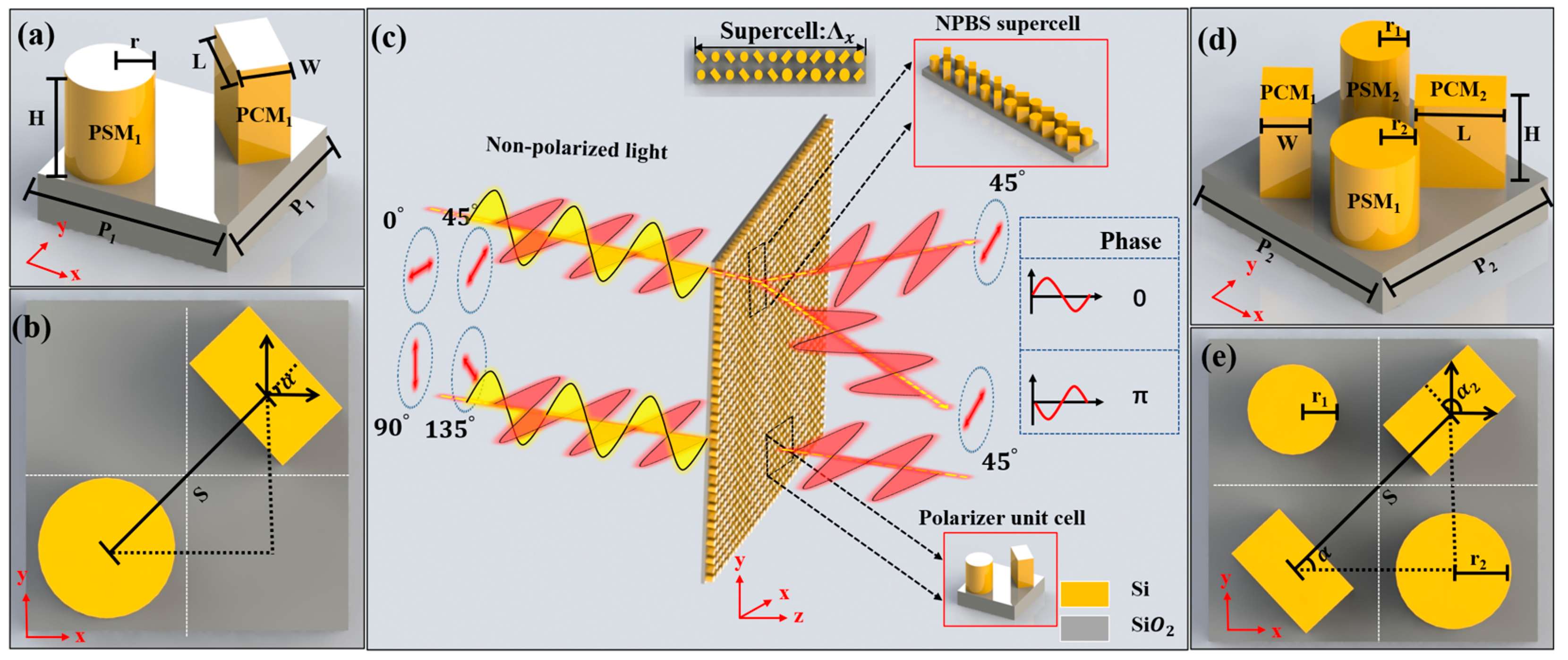
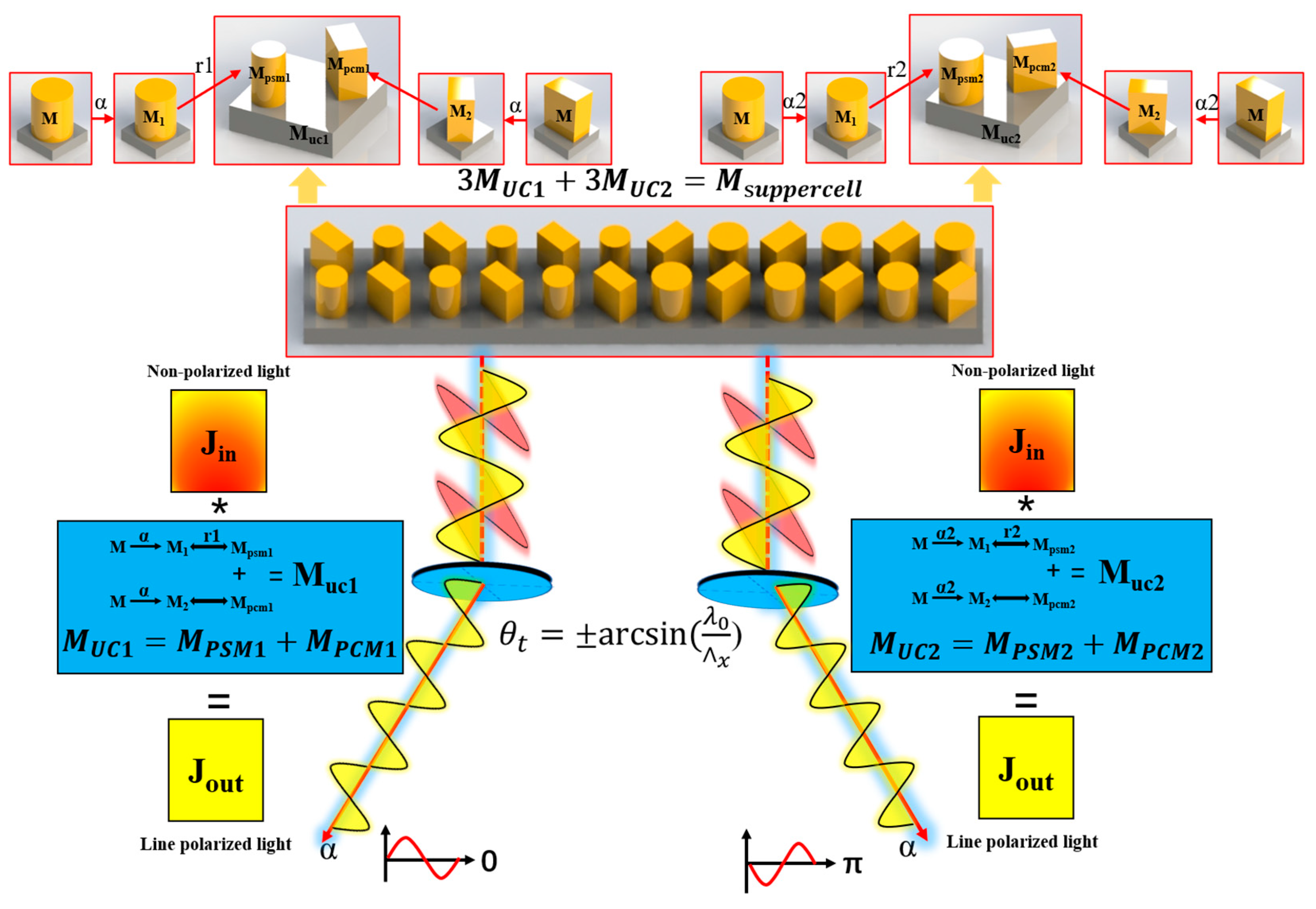

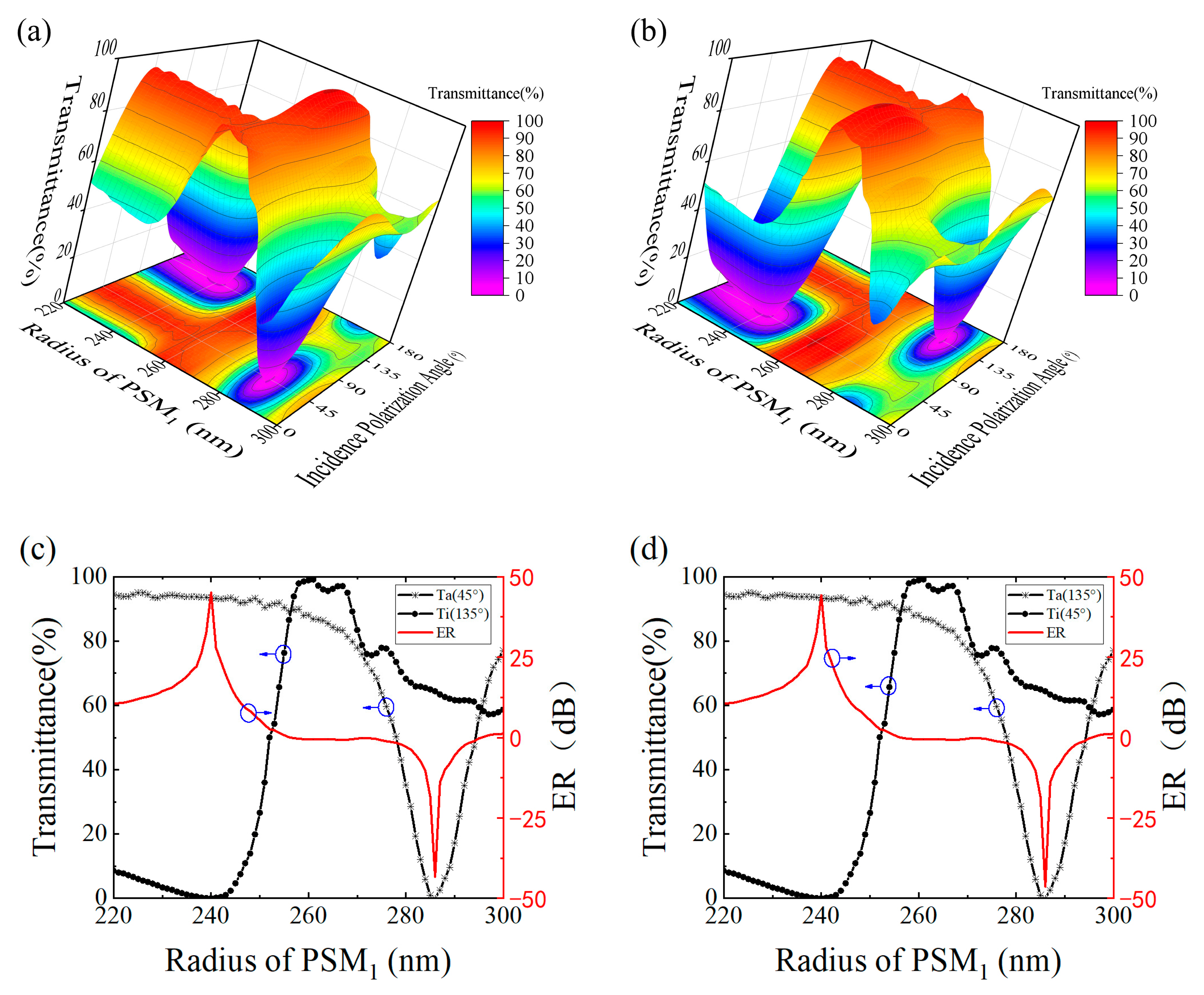
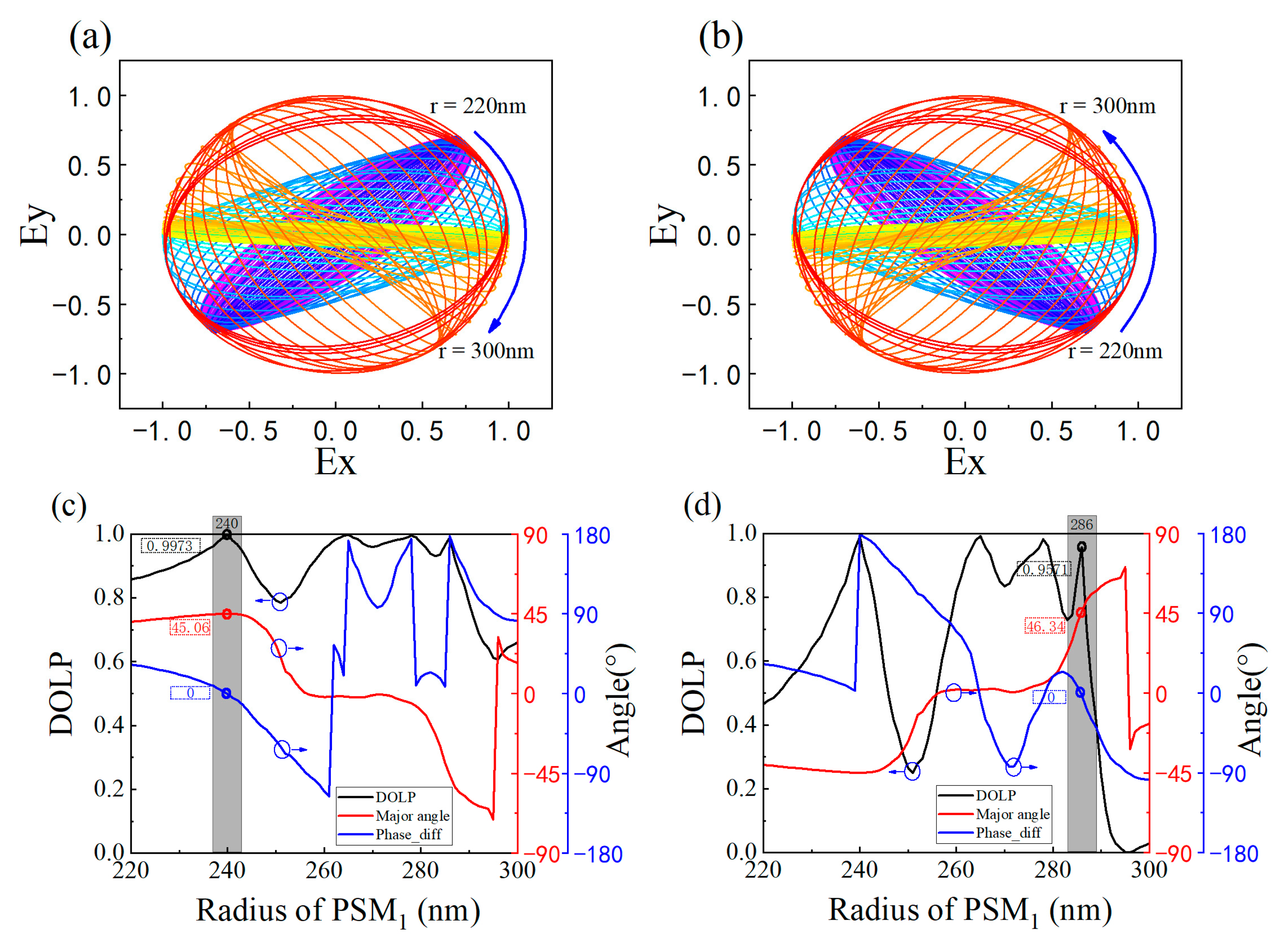
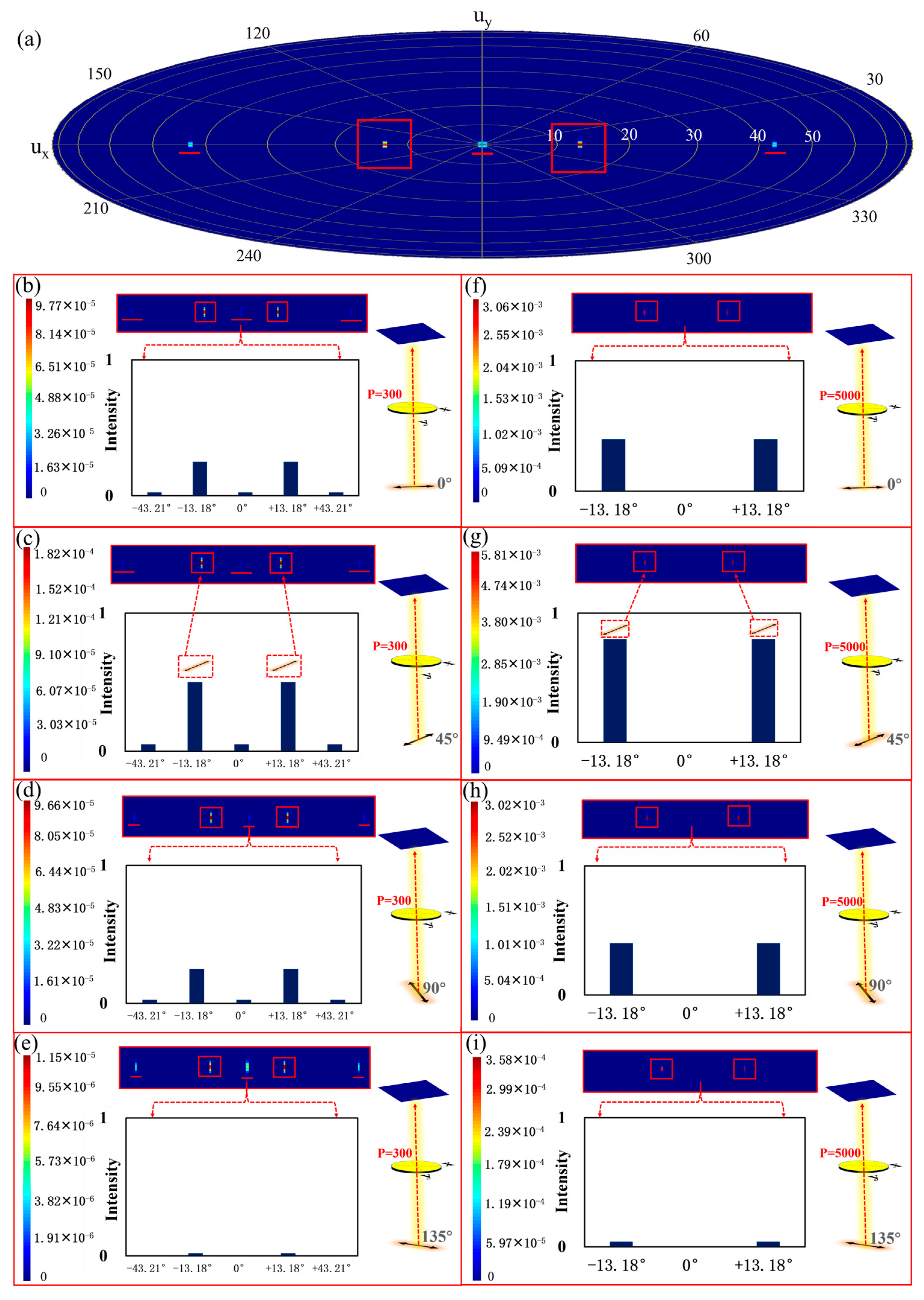
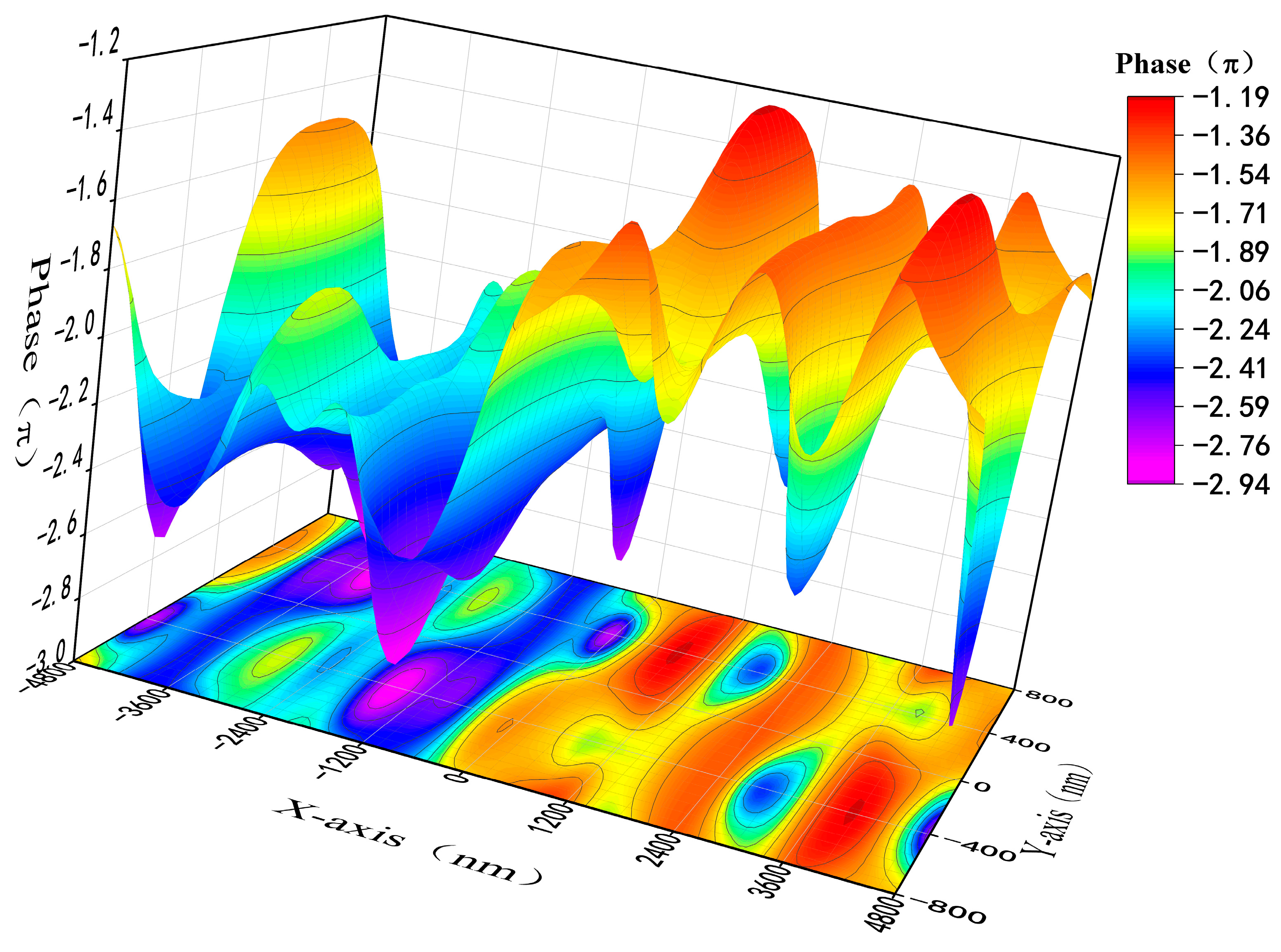
| α (°) | Ta (%) | Ti (%) | ER (dB) |
|---|---|---|---|
| 45 | 92.98 | 0.0207 | 36.53 |
| 135 | 93.02 | 0.0199 | 36.70 |
Disclaimer/Publisher’s Note: The statements, opinions and data contained in all publications are solely those of the individual author(s) and contributor(s) and not of MDPI and/or the editor(s). MDPI and/or the editor(s) disclaim responsibility for any injury to people or property resulting from any ideas, methods, instructions or products referred to in the content. |
© 2023 by the authors. Licensee MDPI, Basel, Switzerland. This article is an open access article distributed under the terms and conditions of the Creative Commons Attribution (CC BY) license (https://creativecommons.org/licenses/by/4.0/).
Share and Cite
Shi, L.; Lu, L.; Chen, W.; Chen, G.; He, Y.; Ren, G.; Zhu, L. Si-Based Polarizer and 1-Bit Phase-Controlled Non-Polarizing Beam Splitter-Based Integrated Metasurface for Extended Shortwave Infrared. Nanomaterials 2023, 13, 2592. https://doi.org/10.3390/nano13182592
Shi L, Lu L, Chen W, Chen G, He Y, Ren G, Zhu L. Si-Based Polarizer and 1-Bit Phase-Controlled Non-Polarizing Beam Splitter-Based Integrated Metasurface for Extended Shortwave Infrared. Nanomaterials. 2023; 13(18):2592. https://doi.org/10.3390/nano13182592
Chicago/Turabian StyleShi, Leidong, Lidan Lu, Weiqiang Chen, Guang Chen, Yanlin He, Guanghui Ren, and Lianqing Zhu. 2023. "Si-Based Polarizer and 1-Bit Phase-Controlled Non-Polarizing Beam Splitter-Based Integrated Metasurface for Extended Shortwave Infrared" Nanomaterials 13, no. 18: 2592. https://doi.org/10.3390/nano13182592
APA StyleShi, L., Lu, L., Chen, W., Chen, G., He, Y., Ren, G., & Zhu, L. (2023). Si-Based Polarizer and 1-Bit Phase-Controlled Non-Polarizing Beam Splitter-Based Integrated Metasurface for Extended Shortwave Infrared. Nanomaterials, 13(18), 2592. https://doi.org/10.3390/nano13182592







